Möchten Sie WordPress lokal auf Ihrem Windows-Computer installieren?
Die Arbeit mit WordPress auf Ihrem Computer ermöglicht es Ihnen, neue WordPress-Funktionen zu testen, zu lernen, wie man mit WordPress entwickelt, und Websites zu erstellen, bevor Sie sie auf den Live-Server migrieren.
In diesem Artikel zeigen wir Ihnen, wie Sie WordPress auf einem Windows-Computer mit zwei verschiedenen Methoden richtig installieren. Dies funktioniert unter Windows 8, Windows 10 und anderen Versionen von Windows.
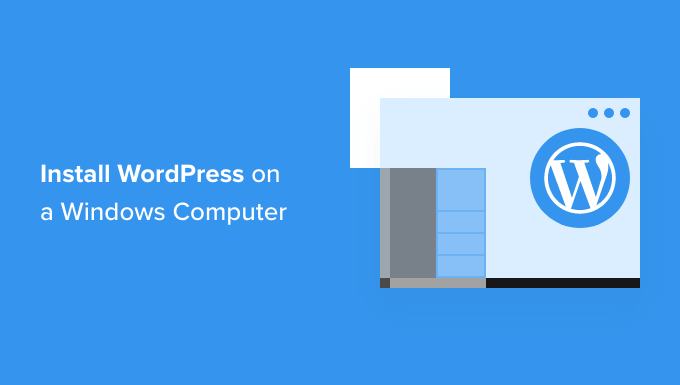
Warum sollten Sie WordPress unter Windows installieren?
Die lokale Installation von WordPress auf Ihrem Computer bietet Ihnen eine Testumgebung, die sich nicht auf Ihre Live-Website oder Ihren Blog auswirkt. Eine WordPress-Installation auf Ihrem Computer wird auch als lokaler Server oder localhost bezeichnet.
Normalerweise verwenden WordPress-Entwickler eine lokale WordPress-Installation, um ihre WordPress-Plugins und -Themes zu entwickeln.
Anfänger können WordPress auch auf ihren Computern installieren, um WordPress zu erlernen, neue WordPress-Themes und Plugins zu testen und zu experimentieren, ohne dass eine Live-Website beeinträchtigt wird.
Hinweis: Wenn Sie WordPress lokal unter Windows installieren, sind Sie die einzige Person, die diese Website sehen kann.
Wenn Sie eine öffentlich zugängliche Website erstellen möchten, benötigen Sie einen Domainnamen und ein Webhosting. Wir empfehlen Ihnen, dieser Anleitung zu folgen, um einen WordPress-Blog zu erstellen.
Werfen wir also einen Blick darauf, wie man WordPress auf einem Windows-Computer richtig installiert. Wir zeigen Ihnen 2 einfache Wege. Klicken Sie auf den Link unten, um zu dem Abschnitt zu springen, der Sie interessiert:
- Methode 1: Installieren von WordPress auf Windows mit Local WP
- Methode 2: Installieren von WordPress unter Windows mit WampServer
WordPress unter Windows mit Local WP installieren
Local WP, früher bekannt als Local by Flywheel, ist eine lokale Websoftware, mit der Sie eine Website auf Ihrem Computer hosten können, anstatt auf einem Staging- oder Live-Server.
Zunächst müssen Sie die Local WP-Software herunterladen und auf Ihrem Windows-Computer installieren. Gehen Sie einfach auf die Local WP-Website und klicken Sie auf die Schaltfläche „Download for Free“.
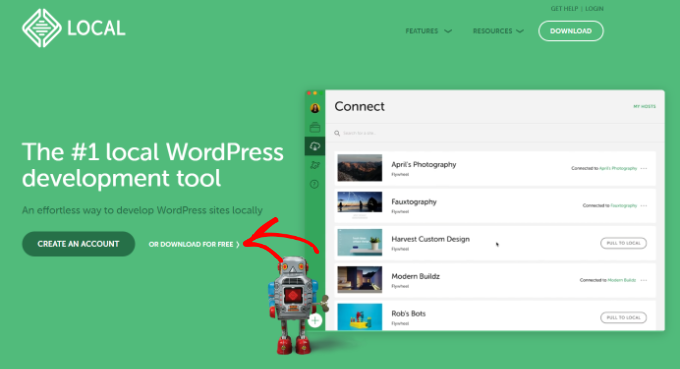
Daraufhin erscheint ein Popup-Fenster, in dem Sie Ihre Plattform auswählen müssen.
Wählen Sie aus dem Dropdown-Menü „Windows“ aus.
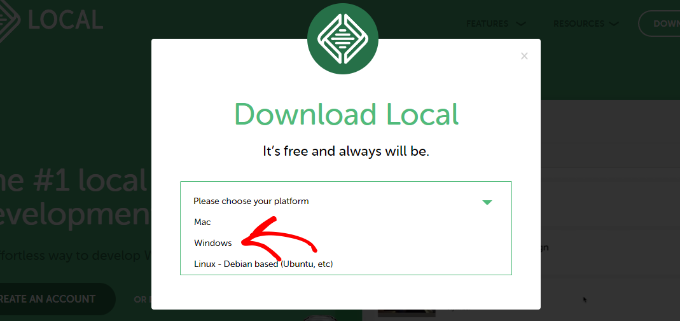
Als Nächstes können Sie Ihre Daten wie Vor- und Nachname, Arbeits-E-Mail-Adresse und Telefonnummer eingeben, um die Software herunterzuladen.
Nach Eingabe der Daten klicken Sie einfach auf die Schaltfläche „Jetzt anfordern“.
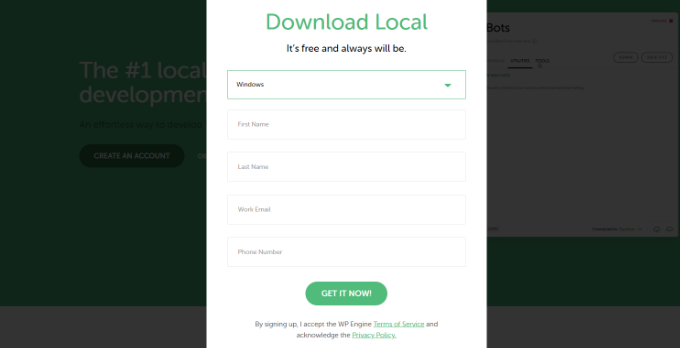
Danach können Sie die Software auf Ihren Computer herunterladen. Sobald sie heruntergeladen ist, starten Sie den Einrichtungsassistenten.
Nun müssen Sie auswählen, ob Sie die Software für alle Benutzer oder nur für sich selbst installieren möchten. Sobald Sie eine Option ausgewählt haben, klicken Sie auf die Schaltfläche „Weiter“.
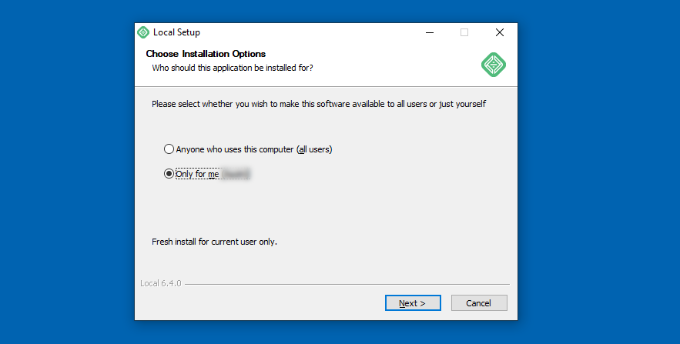
Im nächsten Schritt können Sie den „Zielordner“ auswählen, in dem die Software installiert werden soll.
Klicken Sie einfach auf die Schaltfläche „Durchsuchen“, um den Pfad festzulegen, und klicken Sie dann auf die Schaltfläche „Installieren“.
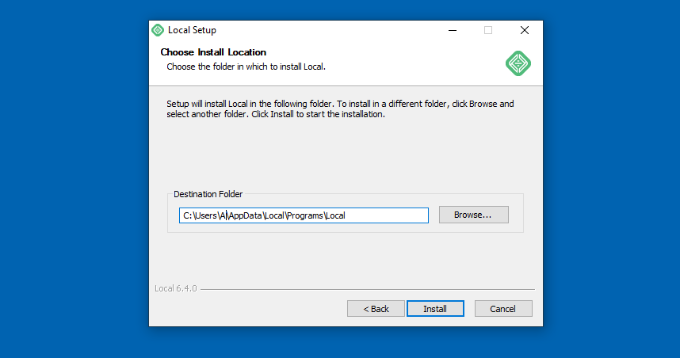
Die Local WP-Software wird nun auf Ihrem Windows-Computer installiert.
Anschließend können Sie das Kontrollkästchen „Lokal ausführen“ aktivieren und im Einrichtungsassistenten auf die Schaltfläche „Fertig stellen“ klicken.
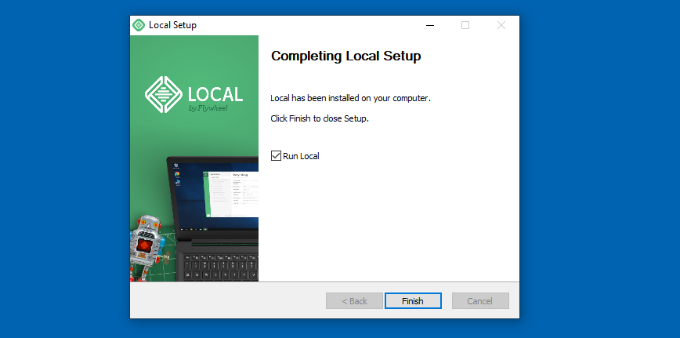
Die Software wird nun auf Ihrem Windows-Gerät gestartet.
Der nächste Schritt besteht darin, eine neue lokale Website hinzuzufügen. Klicken Sie dazu einfach auf das Pluszeichen (+) am unteren Rand.
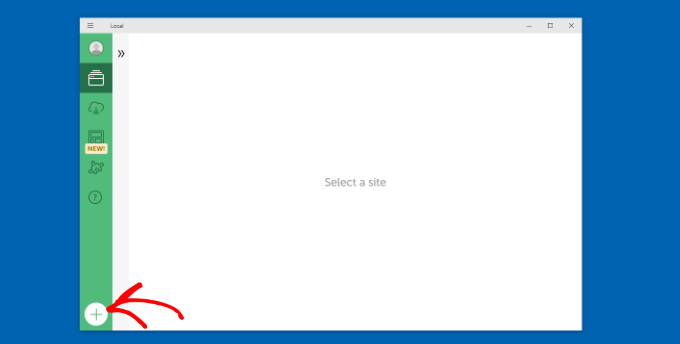
Danach können Sie eine Website in der lokalen Software erstellen.
Wählen Sie die Option „Neue Website erstellen“ und klicken Sie auf die Schaltfläche „Weiter“.
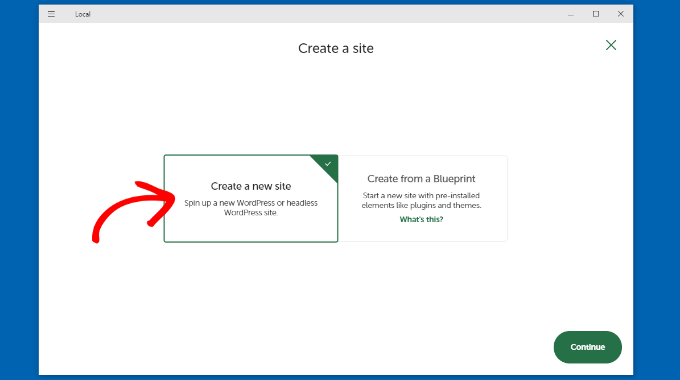
Als nächstes können Sie einen Namen für Ihre lokale Website eingeben, z. B. wordpresslocalsite.
Es gibt auch erweiterte Optionen, bei denen Sie die lokale Site-Domäne und den lokalen Site-Pfad eingeben können. Wenn Sie gerade erst anfangen, empfehlen wir Ihnen, die Standardeinstellungen beizubehalten.
Wenn Sie fertig sind, klicken Sie einfach auf die Schaltfläche „Weiter“.
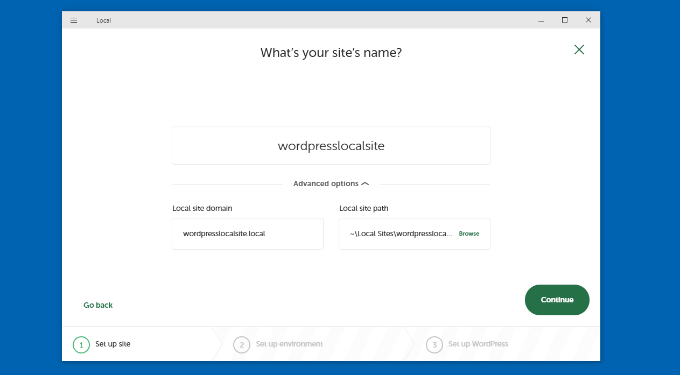
Danach müssen Sie eine Umgebung für Ihre lokale Website auswählen.
Sie können die „bevorzugte“ Umgebung verwenden, in der die Software automatisch die PHP-Version, den Webserver und die MySQL-Version auswählt. Andererseits können Sie auch „Benutzerdefiniert“ wählen und die Umgebungsdetails eingeben.
Für dieses Lernprogramm verwenden wir die bevorzugten Einstellungen und klicken auf die Schaltfläche „Weiter“.
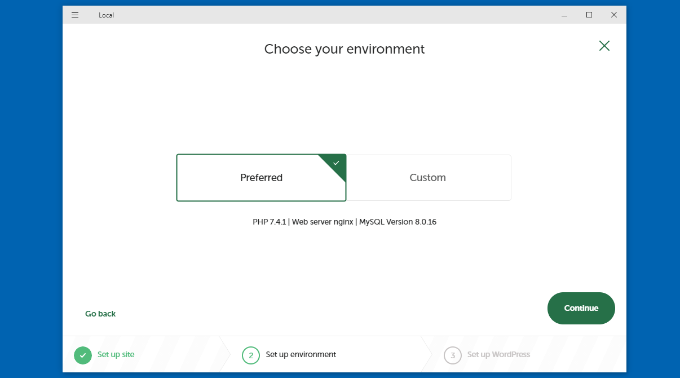
Als nächstes können Sie einen WordPress-Benutzernamen und ein Passwort für Ihre lokale Website eingeben. Außerdem haben Sie die Möglichkeit, eine WordPress-E-Mail-Adresse auszuwählen, an die Sie alle E-Mail-Benachrichtigungen erhalten werden.
Es gibt auch eine erweiterte Option, bei der die Software fragt, ob Sie ein WordPress-Multisite-Netzwerk haben.
Nachdem Sie diese Angaben eingegeben haben, klicken Sie einfach auf die Schaltfläche „Website hinzufügen“.
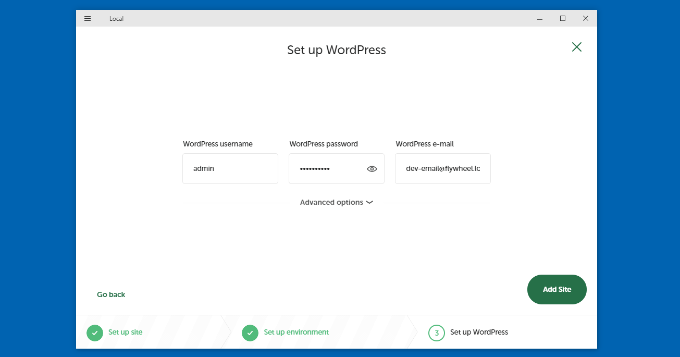
Die Software wird nun WordPress installieren und Ihre Website einrichten.
Um die lokale Website zu starten, klicken Sie in der Software auf die Schaltfläche „WP Admin“.
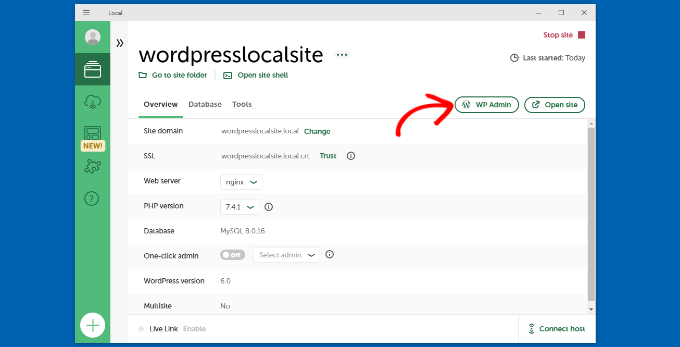
Als nächstes sehen Sie die Anmeldeseite für den WordPress-Admin.
Geben Sie einfach den Benutzernamen und das Kennwort ein, die Sie zuvor bei der Einrichtung der lokalen Website eingegeben haben, und klicken Sie dann auf die Schaltfläche „Anmelden“.
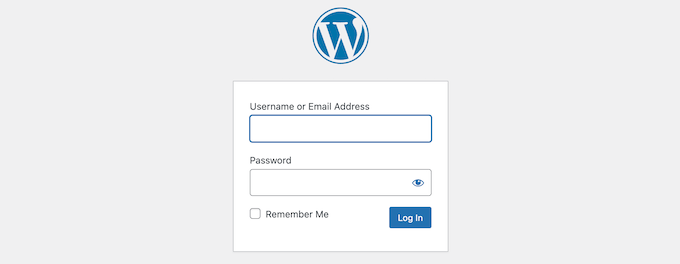
Sie können nun Ihre lokale Website auf Ihrem Windows-Computer bearbeiten.
Wenn Sie fertig sind, vergessen Sie nicht, die Website von der Local WP Software zu stoppen, indem Sie auf die Schaltfläche „Stop site“ klicken.
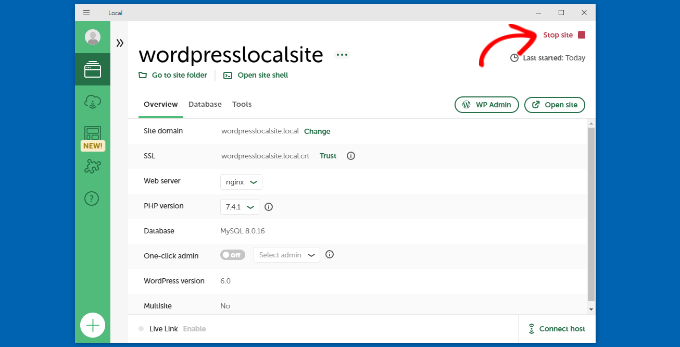
WordPress auf Windows mit WampServer installieren
WampServer oder WAMP ist eine Zusammenstellung von Apache-Webserver, PHP und MySQL, die für Windows-Computer gebündelt ist.
Bei allen handelt es sich um separate Open-Source-Software. Sie separat zu installieren ist jedoch selbst für erfahrene Benutzer nicht ganz einfach. Mit einer Software wie WampServer können Sie sie einfach installieren und haben innerhalb von Minuten eine funktionierende lokale Umgebung.
Zunächst müssen Sie die WAMP-Software herunterladen und auf Ihrem Computer installieren. Gehen Sie einfach auf die WampServer-Website und klicken Sie auf die Schaltfläche „Start Using WampServer“.
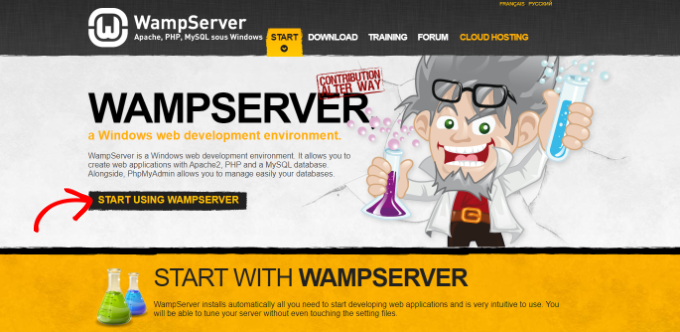
Sie gelangen dann in den Download-Bereich. Hier sehen Sie zwei Versionen: WampServer 32 bits und WampServer 64 bits.
Sie müssen die WampServer-Version auswählen, die dem Betriebssystemtyp Ihres Windows-Computers entspricht.
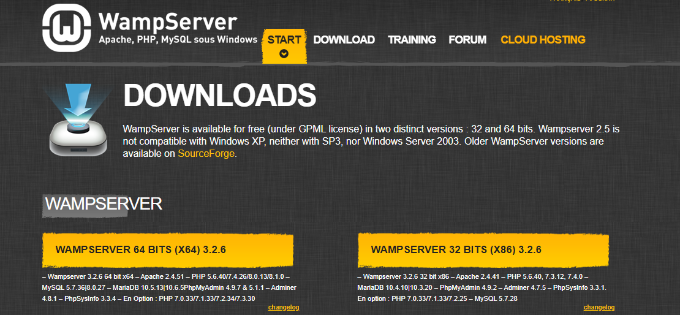
Um herauszufinden, ob Sie ein 32- oder 64-Bit-Betriebssystem verwenden, suchen Sie einfach nach „Systemsteuerung“ in der Suchleiste in der Start-Taskleiste.
Danach können Sie auf Ihrem Computer zu System und Sicherheit “ System gehen. Dort können Sie Ihren Systemtyp sehen.
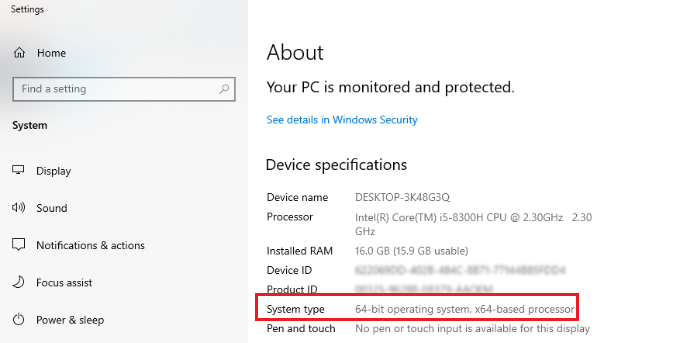
Da Sie nun den Typ Ihres Windows-Betriebssystems kennen, wählen Sie einfach die richtige WampServer-Softwareversion aus.
Wenn Sie auf die Schaltfläche „Herunterladen“ klicken, wird ein Formular geöffnet, in dem Sie nach Ihren persönlichen Daten gefragt werden. Wenn Sie diese Informationen nicht angeben möchten, klicken Sie einfach auf den Link „Sie können es direkt herunterladen“.
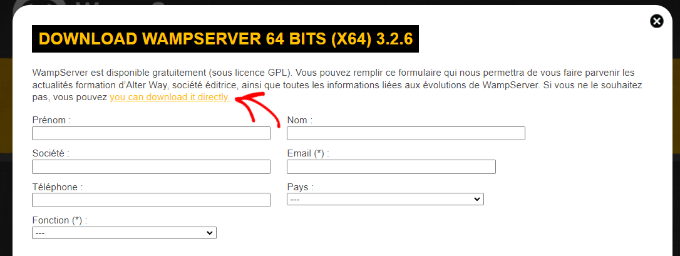
Nach dem Download können Sie auf die Ausführungsdatei von WampServer klicken, um die Installation zu starten.
Wählen Sie nun eine Sprache aus dem Dropdown-Menü und klicken Sie auf die Schaltfläche „OK“.
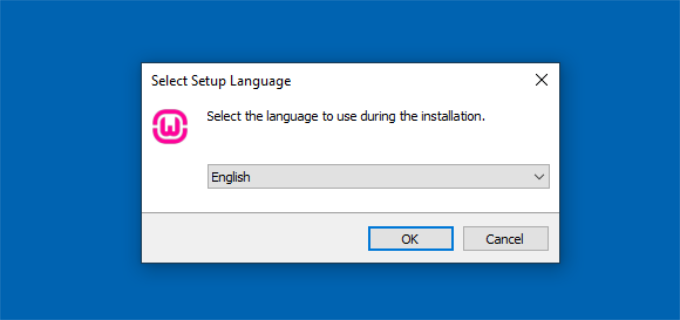
Im nächsten Schritt wird Ihnen die Lizenzvereinbarung angezeigt.
Wählen Sie die Option „Ich akzeptiere die Vereinbarung“ und klicken Sie auf die Schaltfläche „Weiter“.
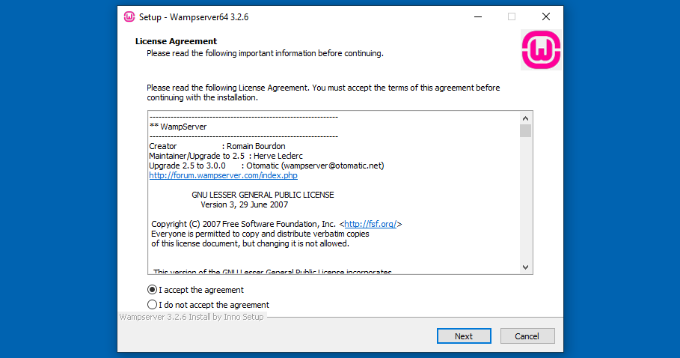
Danach zeigt der Setup-Assistent Informationen über die WampServer-Installation an.
Sie können einfach auf die Schaltfläche „Weiter“ klicken, um fortzufahren.
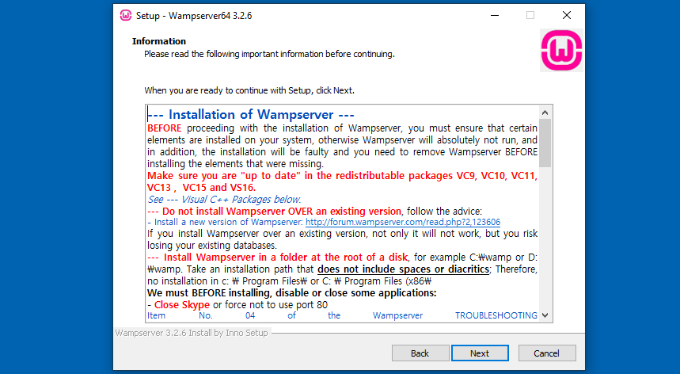
Als Nächstes können Sie den Speicherort auswählen, an dem die Software installiert werden soll.
Um den Standardspeicherort zu ändern, klicken Sie auf die Schaltfläche „Durchsuchen“ und wählen Sie den gewünschten Ordner. Wenn Sie fertig sind, klicken Sie auf die Schaltfläche „Weiter“.
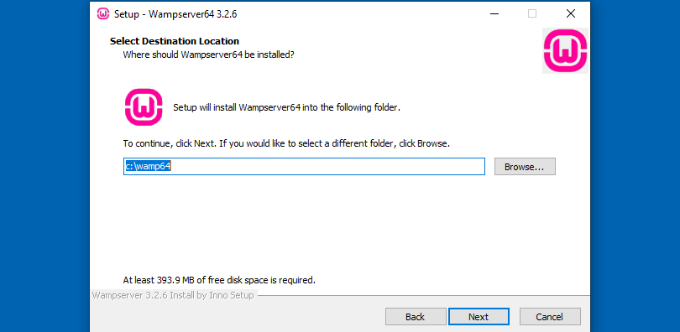
Der Setup-Assistent fordert Sie auf, verschiedene Komponenten auszuwählen, die Sie installieren möchten. Dazu gehören die PHP-Versionen, MySQL-Versionen und mehr.
Sie können auch die Standardoptionen beibehalten und auf die Schaltfläche „Weiter“ klicken, um fortzufahren.
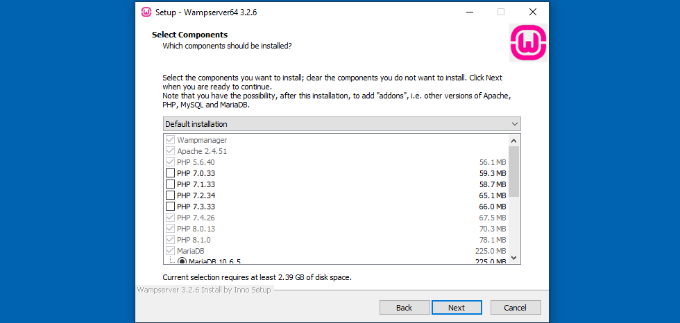
Als nächstes können Sie einen Startmenü-Ordner auswählen. Klicken Sie auf die Schaltfläche „Durchsuchen“, um einen anderen Ordner auszuwählen.
Sobald Sie einen Ordner ausgewählt haben, klicken Sie auf die Schaltfläche „Weiter“, um fortzufahren.
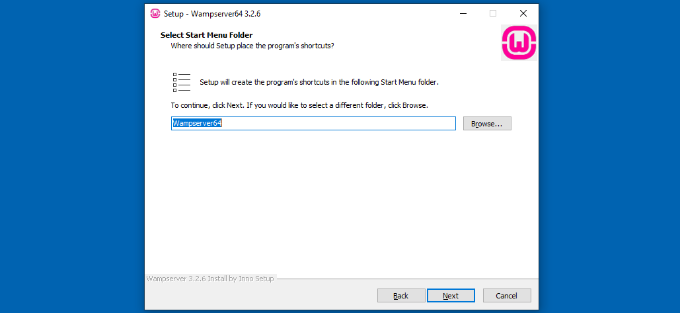
Die Software ist nun bereit für die Installation. Sie können eine Zusammenfassung des Zielorts, des Installationstyps, der ausgewählten Komponenten und mehr sehen.
Klicken Sie nun auf die Schaltfläche „Installieren“.
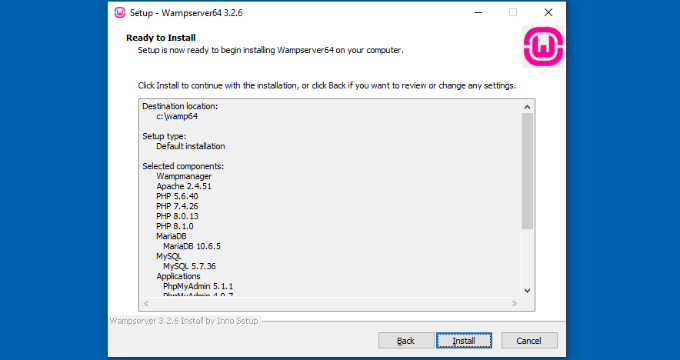
Während des Installationsvorgangs müssen Sie den Speicherort des Webbrowsers festlegen. Standardmäßig ist dies der Internet Explorer.
Sie können ihn in Google Chrome oder einen anderen Webbrowser ändern, indem Sie ihn in den Programmdateien Ihres Computers suchen.
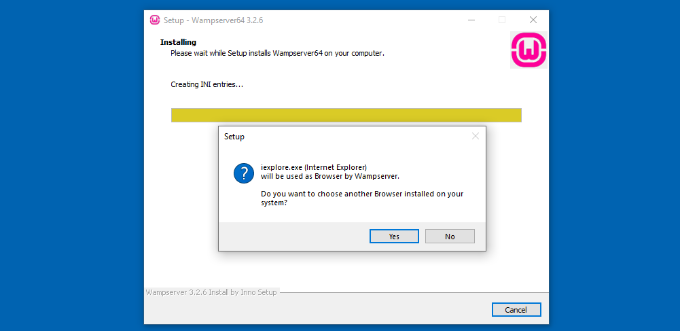
Ebenso werden Sie gefragt, ob Sie Notepad verwenden möchten, wenn Sie WampServer benutzen.
Danach zeigt der Einrichtungsassistent Informationen über die Funktionsweise von WampServer an.
Klicken Sie nun auf die Schaltfläche „Weiter“.
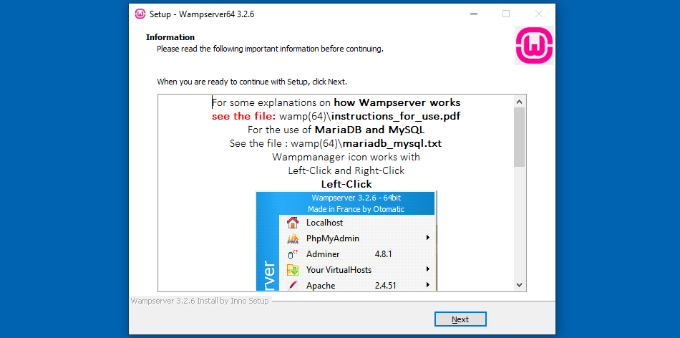
Sie haben nun WampServer erfolgreich auf Ihrem Windows-Gerät installiert.
Klicken Sie einfach auf die Schaltfläche „Fertig stellen“, um den Einrichtungsassistenten zu beenden.
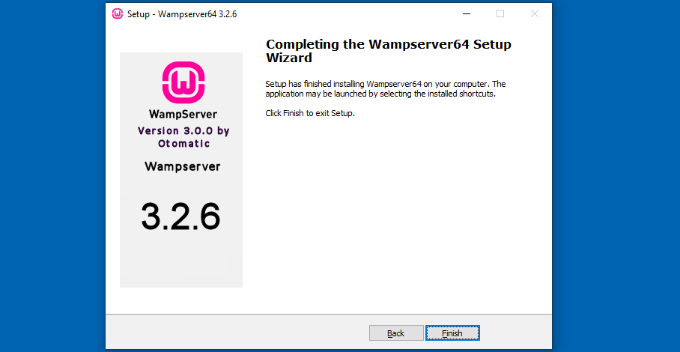
Nach der Installation können Sie den WampServer über Ihre Desktop-Verknüpfung oder über das Zielverzeichnis, in das Sie die Software installiert haben, starten.
Als nächstes müssen Sie eine leere MySQL-Datenbank erstellen.
Wenn Sie WampServer starten, sehen Sie ein grünes Symbol in der unteren rechten Ecke Ihres Bildschirms zusammen mit anderen Symbolen. Klicken Sie einfach mit der linken Maustaste darauf und dann auf phpMyAdmin (eine webbasierte Anwendung zur Verwaltung von MySQL-Datenbanken).
Hinweis: Wenn das WampServer-Symbol rot oder gelb ist, dann bedeutet dies, dass die Dienste (Apache, MySQL, PHP) nicht laufen. Sie müssen die Dienste starten, indem Sie auf das Symbol klicken, bevor Sie die Datenbank einrichten.
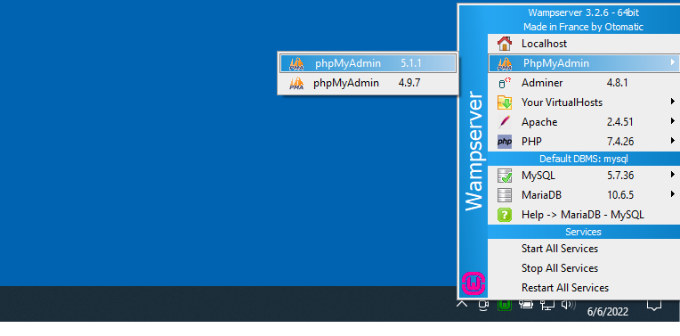
Sie gelangen dann zum phpMyAdmin-Anmeldebildschirm in Ihrem Webbrowser.
Geben Sie einfach den Benutzernamen: root ein und lassen Sie das Passwortfeld leer. Dies sind die Standard-Anmeldedaten für die Anmeldung bei Ihrem localhost phpMyAdmin.
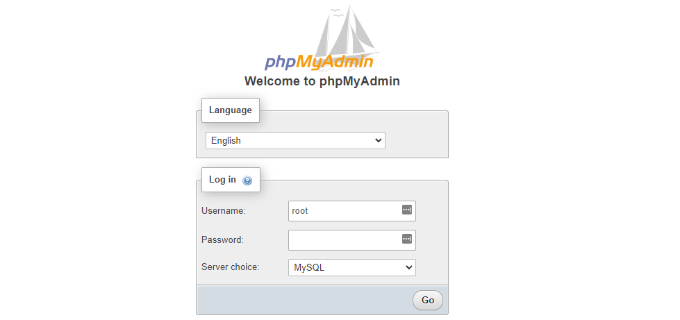
Klicken Sie auf die Schaltfläche „Go“, um fortzufahren.
Sobald Sie eingeloggt sind, müssen Sie in phpmMyAdmin auf Datenbanken klicken, um eine neue Datenbank für WordPress zu erstellen.
Sie werden aufgefordert, einen Namen für Ihre neue Datenbank zu wählen (wir nannten unsere test_db). Klicken Sie anschließend auf die Schaltfläche „Erstellen“.
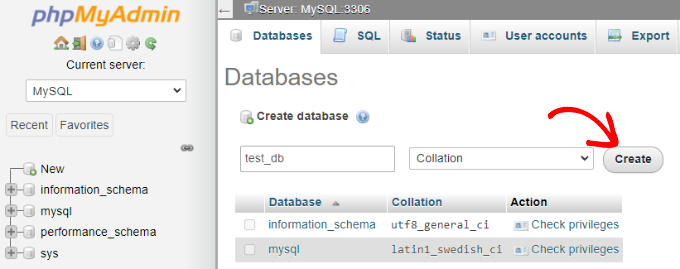
Ihre Datenbank ist fertig, d.h. Sie können WordPress jetzt auf dem lokalen Rechner installieren.
Als Nächstes müssen Sie die neueste Version von WordPress von der Website WordPress.org herunterladen. Sie wird als Zip-Datei heruntergeladen.
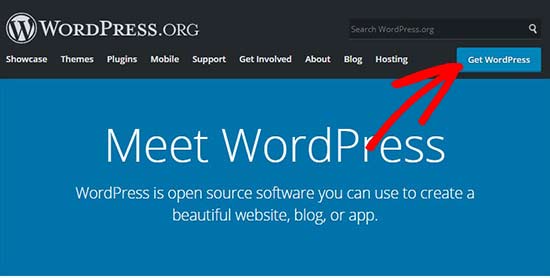
Als Nächstes müssen Sie die Zip-Datei entpacken und den Ordner „wordpress“ kopieren.
In diesem Tutorial verwenden wir WinRAR zum Entpacken der Datei. Klicken Sie einfach oben auf die Option „Entpacken nach“.
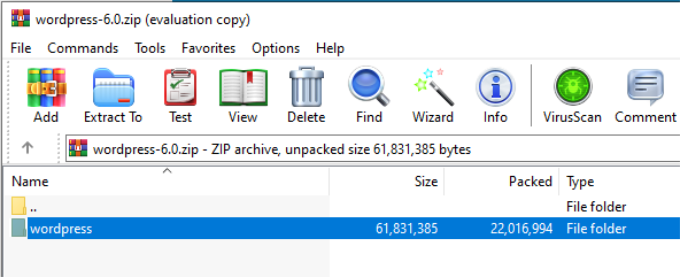
Nun müssen Sie zu dem Ordner navigieren, in dem Sie WAMP installiert haben.
In diesem Lernprogramm haben wir WAMP unter C:\wamp64 installiert, daher werden wir uns im Folgenden auf diesen Ordner beziehen. Beachten Sie jedoch, dass dies bei Ihnen anders sein kann, je nachdem, wo Sie das Programm installiert haben.
Fügen Sie den Ordner „wordpress“ in den Ordner C:\wamp64\www ein.
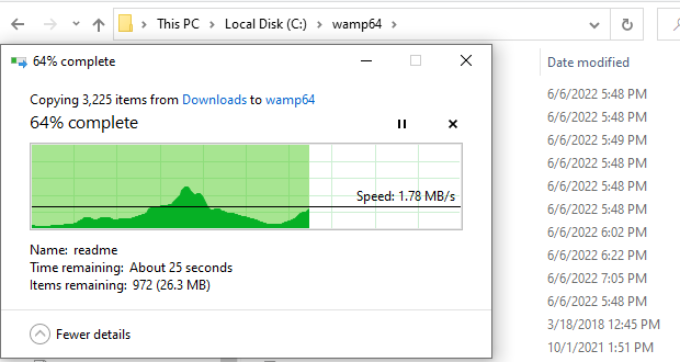
Sie können den Ordner „wordpress“ nach Belieben umbenennen, z. B. mysite, testsite usw. Dies wird die URL Ihrer lokalen WordPress-Site sein. Wählen Sie also eine Adresse, die Sie sich leicht merken können.
Für die Zwecke dieses Tutorials haben wir den Ordner von wordpress in mysite umbenannt.
Als Nächstes können Sie den Webbrowser öffnen, zu http://localhost/mysite/ gehen und auf den Ordner „wordpress“ klicken.
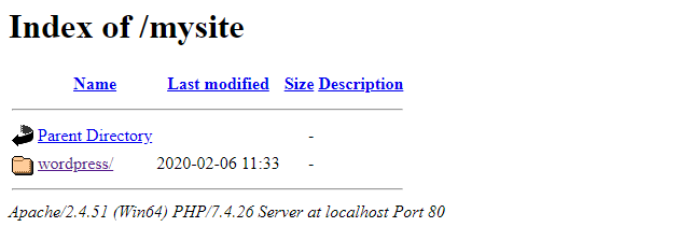
Zunächst werden Sie aufgefordert, eine Sprache auszuwählen, und dann werden Ihnen die Informationen zur Einrichtung der Datenbank angezeigt.
Nachdem Sie eine Sprache ausgewählt haben, klicken Sie auf die Schaltfläche „Weiter“.
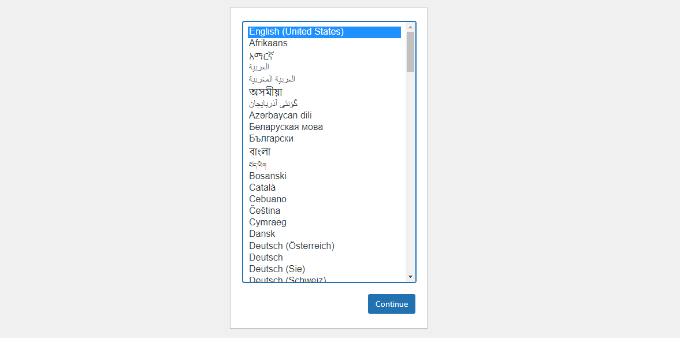
Als Nächstes sehen Sie einen Willkommens-Hinweis für WordPress.
Wenn Sie sie sorgfältig gelesen haben, klicken Sie auf die Schaltfläche „Los geht’s“, um fortzufahren.
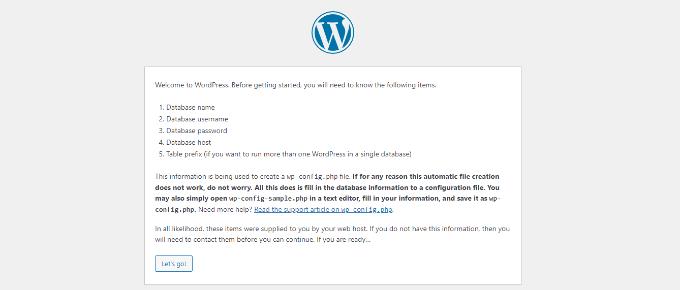
Danach müssen Sie Ihre Datenbankdetails wie Datenbankname, Benutzername, Passwort, Host und Tabellenpräfix eingeben.
Der Name der Datenbank ist der, den Sie im vorherigen Schritt eingegeben haben. In unserem Fall haben wir sie „test_db“ genannt. Der Benutzername ist „root“, und das Passwortfeld können Sie leer lassen. Sie können auch den Datenbank-Host und das Tabellenpräfix unverändert lassen.
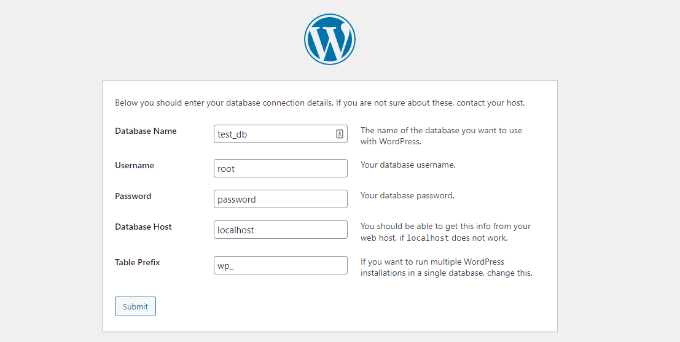
Klicken Sie anschließend auf die Schaltfläche „Absenden“, und WordPress wird im Backend eine Konfigurationsdatei für Sie erstellen.
Auf dem nächsten Bildschirm sehen Sie eine Erfolgsmeldung, die besagt, dass WordPress mit Ihrer Datenbank verbunden ist, und Sie können mit der Installation fortfahren.
Klicken Sie auf die Schaltfläche „Installation ausführen“, um fortzufahren.
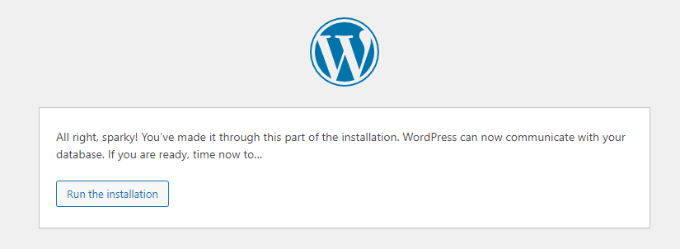
Sie werden zum Willkommensbildschirm für WordPress weitergeleitet. Sie müssen einen Titel für Ihre neue WordPress-Website hinzufügen, einen Administrator-Benutzernamen wählen, ein sicheres Passwort eingeben und eine Administrator-E-Mail-Adresse angeben.
Sobald Sie bereit sind, klicken Sie auf die Schaltfläche „WordPress installieren“.
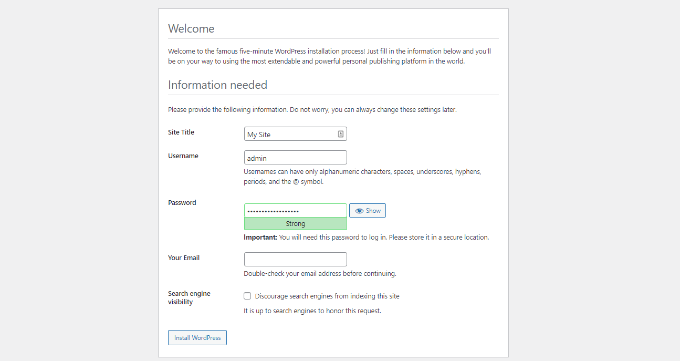
Nachdem der Installationsvorgang abgeschlossen ist, wird eine Erfolgsmeldung angezeigt. Im Hintergrund hat WordPress neue Tabellen in Ihrer Datenbank erstellt und ist nun einsatzbereit.
Sie können dann zu Ihrem WordPress-Dashboard gehen, indem Sie auf die Schaltfläche „Anmelden“ klicken.
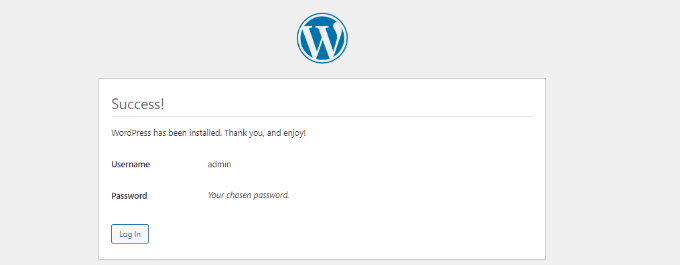
Herzlichen Glückwunsch, Sie haben WordPress mit WampServer erfolgreich auf einem Windows-Computer installiert.
Loggen Sie sich einfach in Ihr WordPress-Administrationspanel ein und beginnen Sie mit der Bearbeitung Ihrer Website in einer lokalen Umgebung.
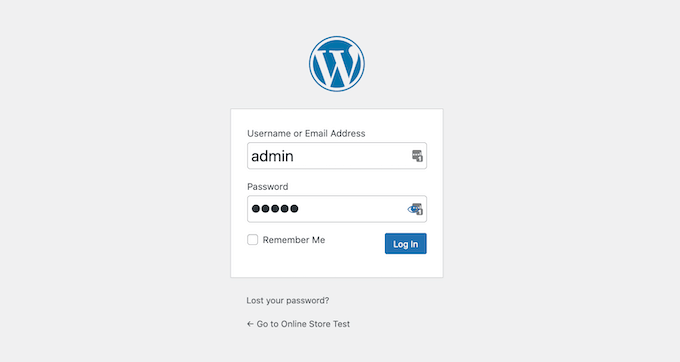
Aktivieren von Pretty Permalinks in WAMP
Die neue Version von WordPress macht Ihre lokale Website nicht kaputt, indem sie die Permalinks-Einstellung ändert.
Wenn Sie jedoch immer noch die Fehlermeldung „Seite nicht gefunden“ auf Ihren Seiten sehen, nachdem Sie die Permalinks unter Einstellungen “ Permalinks in WordPress geändert haben, dann folgen Sie einfach unserer Anleitung, wie Sie benutzerdefinierte Permalinks in WAMP aktivieren.
Bonus: WordPress von lokal nach live migrieren
Wir haben auch einen separaten Leitfaden für den Umzug von WordPress vom lokalen Server auf eine Live-Site geschrieben. Hoffentlich finden Sie ihn hilfreich, wenn Sie bereit sind, Ihre lokale Website in die Produktion zu überführen.
Eine lokale Serverumgebung ist für Lern- und Testzwecke ideal. Wenn Sie jedoch einen WordPress-Blog starten möchten, den andere Leute sehen können, dann müssen Sie WordPress nicht auf Ihrem Computer installieren. Sie müssen WordPress bei einem WordPress-Hosting-Anbieter installieren.
Wir hoffen, dass dieser Artikel Ihnen geholfen hat, WordPress auf einem Windows-Computer zu installieren. Vielleicht interessiert Sie auch unser Leitfaden zu WordPress-SEO und wie man einen Online-Shop eröffnet.
Wenn Ihnen dieser Artikel gefallen hat, dann abonnieren Sie bitte unseren YouTube-Kanal für WordPress-Videotutorials. Sie können uns auch auf Twitter und Facebook finden.





Syed Balkhi says
Hey WPBeginner readers,
Did you know you can win exciting prizes by commenting on WPBeginner?
Every month, our top blog commenters will win HUGE rewards, including premium WordPress plugin licenses and cash prizes.
You can get more details about the contest from here.
Start sharing your thoughts below to stand a chance to win!
Francesco says
Hi,
Can I use this system to test a previous back up I did via the server control panel?
I have a zip file which is a mirror of my directory on the server, including database and WP-admin file.
I would line to test if the backup I have works fine and possible run it on a precioys version of the WP
WPBeginner Support says
You would want to check with the tool you are using for the specifics but it should allow you to do what you’re wanting.
Admin
Melissa T says
Installed WAMP and WordPress – thanks for the wonderfully detailed instructions! So now it’s time to create the web site — is there a guide on wpbeginner for that?
thank you!
WPBeginner Support says
There are many different types of sites so there is no complete guide but for a starting point you may want to take a look at our article below. Step 3 and beyond in the guide should help.
https://www.wpbeginner.com/guides/
Admin
kwestyon says
First, thank you so much for the guide! It’s working. Second, is there a way wherein after you create the website, would there a way to view the site after you clicked the published button. Sorry for the dumb question.
WPBeginner Support says
If you are logged in, in the top right you should be able to open the dropdown that has your site title, and there you should find a link to view your site.
Admin
Yomi says
Hello,
If I install WordPress on a localhost based on the content of this blog, will I be able to use plugins like woocommerce, elementor, astra & kadence?
Thank you.
WPBeginner Support says
Yes, installing locally you would be able to use plugins and page builders like those on your site
Admin
Lisa says
Hi,
I am at the point where I would put localhost/mysite/ in the browser. I am getting the „404 not found error“.
I named the copy of wordpress to wamp the same and have double checked the address to see if it’s typed in correctly. This still happens, what am I doing wrong?
Thanks!
WPBeginner Support says
You would want to ensure you’re not running into the Skype error where it is trying to use port 80 while WAMP is.
Admin
WPBeginner Support says
Currently, the WAMP website is down which is why we’ve added a different link and included a note above and are working on updating this article as quickly as we are able
Admin
mark says
WAMP link redirects to a different site.
Faten says
Hi team,
I followed the guide but when I go to local host/my site/ I have this error: your don’t have permission to access my site on this server.
Can you please help?
My folders are in this order: c/wamp/www folder/mysite, is that correct?
WPBeginner Support says
That is the correct location, you would want to ensure WAMP is running when you see that specific error message.
Admin
Sam says
Our published website was created using an older versions of WP, themes, and plugins. I would like to test against the latest versions of WP, themes, and plugins on a local PC installation.
If I backup the website data from the live online WP account using UpdraftPLus, can I restore the files on the local installation to test against the latest versions of WP, themes, and plugins?
If not, what is the most effective method to do so?
Thank you so much!
WPBeginner Support says
You can do that or you could create a staging environment here:
https://www.wpbeginner.com/wp-tutorials/how-to-create-staging-environment-for-a-wordpress-site/
Admin
Jerelyn says
Hi, the WampServer link (website) has not been working the past few days. Is there an alternative place to get it? Thanks.
WPBeginner Support says
Not that we would recommend at the moment, hopefully, the issues on the site at the moment are resolved and the site starts working again soon.
Admin
Harry says
I am trying to do the localhost/mysite/ part but every time I search this it says url not found how do I put the WordPress folder with the WAMP folder
WPBeginner Support says
You would go to where you installed WAMP on your computer, and place the mysite folder inside the www folder
Admin
Jyoti says
I installed WAMP and able to see a GREEN icon in system tray.
But i am not able to see anything when i click on that icon.No PHP database nothing at all.I uninstalled and reinstalled but didn’t work.
Would you please help?
thank you so much.
WPBeginner Support says
You would normally want to enter localhost in your browser while the green W is in your icon tray to find that
Admin
Pete says
I installed WampServer, but it wouldn’t run. All I saw was a couple of windows with command prompts briefly appear and then disappear.
WPBeginner Support says
You should see the WAMP icon if you expand your icon tray in the bottom right
Admin
HSM says
it happened with me, and solved it like that:
when entering the database name, and user name,
you may forgot and left the default password as written „Password“
(as happened with me)
without change it to a private password or at least remove the word „Password“ and keep the field of password blank,
WPBeginner Support says
Thanks for sharing the issue you ran into should others have this issue
Admin
Tracy De says
Thanks for this. I was having trouble at this point. Have reinstalled everything and couldn’t work out what I was doing wrong.
Bain Dom says
Can I install WordPress plugins in this WordPress on Windows 10 environment?
WPBeginner Support says
Unless the plugin specifies otherwise(mainly plugins that connect to 3rd party services), you would be able to use plugins on a local installation
Admin
Chloe says
Hi, I followed this guide a few weeks ago and set up the very beginnings of a test site. I now can’t remember or work out how to get back to editing the site! It’s maddening as I can launch WAMP, go to localhost/testsite/ and view the site I made but please can someone let me know how to enter editing mode!! Many thanks
WPBeginner Support says
You would want to add /wp-admin to be able to log into your local installation of WordPress to be able to start editing it again
Admin
Kathleen says
Thank you!!! Exactly what I needed to develop before making a site live
WPBeginner Support says
You’re welcome, glad our guide could be helpful
Admin
Kathleen says
Installed Wamp with no trouble thanks to your concise directions. However, after creating my database and starting the WP install I get this message:
„We were able to connect to the database server (which means your username and password is okay) but not able to select the ericajlester database.“ I have been over and over checking everything to make sure the information is correct, but WP will not connect to the database. Any suggestions would be appreciated.
Thank you for such great information and support!
WPBeginner Support says
The most common reason for this would be a typo in your database name, you would want to ensure the database information and prefix are both correct compared to what you have set
Admin
Alexis says
Thank you so much!
WPBeginner Support says
You’re welcome
Admin
Linda says
Good job is done by Wpbeginner team!!!
Have a great day!
WPBeginner Support says
Thank you, hope you have a great day as well
Admin
Daniel says
Developing WP plugin for a client. Wanted to create a dev environment without paying for hosting space to do it. Thanks for the quick and dirty path to get there.
WPBeginner Support says
Glad our article could help
Admin
Vic Iyke says
This is a real life saver, thank you for the detailed instructions, it saved my time.
WPBeginner Support says
Glad our guide was helpful
Admin
Erica says
Thank you for the guidance..
WPBeginner Support says
You’re welcome
Admin
Harish Nemade says
After doing work on WordPress from WAMP, should we click on ‚Stop all services‘?
WPBeginner Support says
only if you wish to turn of WAMP and your local installation
Admin
Harish Nemade says
The Website of WAMP which you had mentioned is not working anymore. The download is not responding from Sourceforge.net,
WPBeginner Support says
From testing, the link is page is still working on our end, you may want to ensure this isn’t due to a browser or browser addon preventing your download.
Admin
Harish Nemade says
Hey, I installed WAMP in the Internet Explorer folder, but once when I checked to search for my same localhost running on Explorer appeared in Chrome. But can I also Use the same Localhost from Chrome?
WPBeginner Support says
If you installed your site in the wamp folder then you should be able to visit the site at localhost on any browser on that computer
kamodh singh says
localhost/phpmyadmin not opening with any browser. when trying to open there are showing an error ( This site can’t be reached – ERR_CONNECTION_RESET )
How can i fix this error plz tell me .
thanks…
WPBeginner Support says
If you’ve shut down your computer since the last time you used WAMP you would want to ensure it is running before visiting localhost.
Admin
Divyanshu Garg says
Thank you very much for your guidance step by step.
WPBeginner Support says
You’re welcome
Admin
Nena Rahin says
The code execution cannot proceed because MSVCR120.dil was not found. Reinstalling the program may fix the problem.
The code excicution cannot proceed because VCRUNTIME140.dil was not found.
Reinstalling the program may fix the problem.
I get this error even after reinstalling many times.
Please help
WPBeginner Support says
You would want to download the C++ redistributable we link to in the article and that should get you past these errors.
Admin
Dean says
Hi, Thank you so very much for being here! All your information etc. is truly a gift, and it’s appreciated very much!
I’ve successfully installed WAMP and WordPress on my local computer and have played around somewhat. I’d like to refresh WordPress to start fresh again. Can you point me in the direction of doing this?
Thanks much!
Dean
WPBeginner Support says
You could either delete the WordPress folder and install a new WordPress site or you could reset your database using the method in our article here: https://wordpress.org/plugins/wordpress-database-reset/
Admin
Dean says
Thanks so much!
WPBeginner Support says
Glad we could help
Elizabeth says
Great tutorial. I’ve been building sites for a long time in Dreamweaver, switched to WordPress in 2015 and am now using Divi by Elegant Themes to build my sites. I need to rebuild an existing website for a yoga studio I did in 2015 without bringing down the current site and this is just the answer! Fabulous job in explaining step-by-step how to do it. Thank you so much! I am so excited to get working on this!!!
WPBeginner Support says
Glad our tutorial could help
Admin
Marama says
I’ve been thinking about the blogging thing and didn’t want to go straight into a Live site. This tutorial is awesome Thank you. I have installed WordPress to a localhost and now I can put everything in my test site. So Stoked!!
WPBeginner Support says
Awesome, glad our article could help you get a localhost site set up for you to test
Admin
Mike says
Quick question, Which ports rely on this, so i can create firewall rules in our firewall as well as have our Server Team create them in windows? Thanks for any info.
WPBeginner Support says
Sadly, there are too many programs that may or may not use the ports for us to give a list at the moment.
Admin
Thelynx says
Thank you for this excellent tutorial. I have been a WP webmaster for about a year at work and finally decided to set up my own page about flight simulation. I followed the instructions to the letter and now have WP setup on my home PC ready to build the next earth shattering website. I am by no means a noobie to the net, but never dug into all this. Without your help, I’d be floundering. Thank you again. The WPverse is truly a grand community.
WPBeginner Support says
You’re welcome, glad our guide could help you
Admin
Anupama says
I am having an issue with my login setup it says. (see it below) even though I login in PHP server with new data still says that. what am I gonna do.?
Error establishing a database connection
This either means that the username and password information in your wp-config.php file is incorrect or we can’t contact the database server at localhost. This could mean your host’s database server is down.
Are you sure you have the correct username and password?
Are you sure that you have typed the correct hostname?
Are you sure that the database server is running?
If you’re unsure what these terms mean you should probably contact your host. If you still need help you can always visit the WordPress Support Forums.
WPBeginner Support says
You would want to edit your wp-config file in a text editor and ensure your information in this file is correct. We have an article on how to edit it here: https://www.wpbeginner.com/beginners-guide/how-to-edit-wp-config-php-file-in-wordpress/
Specifically, the database name is normally where problems can happen
Admin
Mike says
Thank you very much for this awesome solution. I was searching for something like that and I have seen that you have provided an additional tutorial of how to deploy the offline WP website to a web hoster. Great work THX again.
WPBeginner Support says
You’re welcome, glad our guides can be helpful
Admin
Emm Man says
For all who faced the issue ‚404‘ when tried ‚localhost/{yourSiteName}‘, one possible solution (for me at least) is to add also the port of wamp server e.g. localhost:8080/{yourSiteName}
WPBeginner Support says
Thanks for sharing a possible solution
Admin
Su says
I am building a website for a friend. She already has an old site which is live. I plan to build the new one locally using WAMP.
However, while working on it how do I share my progress with her? So that she can revert for any changes.
WPBeginner Support says
There isn’t a simple method for allowing someone to view your local installation, you may want to check with the hosting provider to see if there is the option of a staging environment for an easier method of what you’re wanting.
Admin
Caragh says
Thanks for the great step by step guide.
Just wondered if I could screen share say through skype or Zoom?
WPBeginner Support says
That is one possibility it just means that the user can’t directly interact with the site.
JAcob says
Hi I would like to install/ run my sample wordpress site off of an external harddrive on various machines of my choosing. Is there any special instructions for this or do I simply install WAMP as described except onto the external drive?
WPBeginner Support says
It is an older article, but for what you’re wanting you would use XAMPP: https://www.wpbeginner.com/wp-tutorials/how-to-install-wordpress-on-a-usb-stick-using-xampp/
Admin
Adam Bermingham says
Hi, you missed an entire step, and it’s a complicated one. All the MS C++ applications. I don’t know what to download or where to save them. Very confusing. There must be an easier way to host a demo WordPress site than this??
WPBeginner Support says
Thanks for letting us know, we will certainly look to include that information when we update this article. For the time being, you should be able to go to the WAMP forums and the specific files should be linked and you would only need to install them where they automatically set their installations
Admin
Duncan McCormack says
You don’t need all of them, just the ones shown in the WAMPserver page when you click either download (it’s the second „warning“ – yes, it’s in French) – just get the 64/32bit versisons of those.
Richard says
hi, first of all thanks for the amazing tutorials!
i have a question – I want to create my first website with wordpress. i thought about using wamp to save the money of the domain use and hosting and then move the website to the domain after it is done.
do you think that’s a good idea? will it be a problem to move the website from the local server to the live site as described it this tutorial? –
https://www.wpbeginner.com/wp-tutorials/how-to-move-wordpress-from-local-server-to-live-site/
WPBeginner Support says
You could certainly create your site locally and then follow the steps in that article to move your site and you shouldn’t run into any problems.
Admin
Sakil Ahmed says
I uninstalled Skype and installed visual C++ but after installing WAMP Server app, clicking the wamp icon in the system tray doesn’t effects and the pop-up to create a database from myphpadmin doesn’t open.
WPBeginner Support says
You may want to check the Skype conflict we mention in the article and should that not be the issue, reach out to WAMP’s support to see if there is a possible known issue.
Admin
Deepti says
Hi
I am planning to make a website of my own . Its basically a food blog. I ahve a good knowledge of programming. However, I have a gap of around 7 yrs and really dont know the new stuff in programming like bootstrap, etc..I am still in learning phase for these concepts.
Would u suggest me to make a website using wordpress.org or wordpress.com?
WPBeginner Support says
We would normally recommend a WordPress.org site, you can see our comparison here: https://www.wpbeginner.com/beginners-guide/self-hosted-wordpress-org-vs-free-wordpress-com-infograph/
Admin
Jem says
Hi there,
I am building wordpress.com site as the client didn’t want to manage hosting separately. I have only ever used wordpress.org. Can you still design the site on a local server and upload in when completed onto a wordpress.com site? I am a little unsure of the limitations of the .com version.
Thanks so much
WPBeginner Support says
You would not be able to upload a new site on WordPress.com, you would normally need to build the site from the beginning on WordPress.com due to their restrictions.
Admin
Seema says
Hi,
This is a great tutorial.
I am stuck with „Error establishing a database connection“ error since a day. For me WAMP works fine, I created a DB then unzip the WP. After localhost/mysite it goes till language selection page get the DB details and when i submit it gives above mentioned error. Tried putting DB details in wp-config-samle.php, same error. Deleted DB created again, deleted mysite folder created again but still same error. Can somebody please help?
WPBeginner Support says
For that error on localhost you may want to ensure you have all of your database information set properly. The database information is normally root with a blank password or you could add a space if it is preventing you from leaving it blank unless you changed that login information.
Admin
Onur SANIR says
Hey I found the solution.
Left Click Wamp Icon > Mysql x.x.x > Use port other than 3xxx > Press Ok
Bobby says
Any way to take a copy of my live hosted site from iPage and put a copy on the WAMP for testing with plugins, etc?
If so how would I do that?
WPBeginner Support says
You would want to take a look at our guide on how to do that here: https://www.wpbeginner.com/wp-tutorials/how-to-move-live-wordpress-site-to-local-server/
Admin
Hang says
Thank you so much <3
WPBeginner Support says
You’re welcome
Admin
Jason says
Worked awesome. Thank you.
WPBeginner Support says
Glad our guide helped
Admin
Barbara says
Wow! So straightforward! Thank you!
WPBeginner Support says
Glad our article was helpful
Admin
Henrik says
Hi, first of all thanks for a very helpful post. Secondly, a question: will having multiple wordpress installations in a single database affect the migration to a live environment when the time comes? Or should I just deploy a new database to be on the safe side? cheers
WPBeginner Support says
You would want to use a database for each site to make transferring environments easier.
Admin
Joe says
Thanks so much. Very well written installation guide. Installed without a single glitch.
WPBeginner Support says
Glad our guide could help you
Admin